Human Flower Project
The Fruited Plain
Sometimes it takes a foreign visitor to open one’s eyes to the U.S.A. Allen Bush gets a heaping helping of Kansas and Nebraska flora, fruit, and pastry.
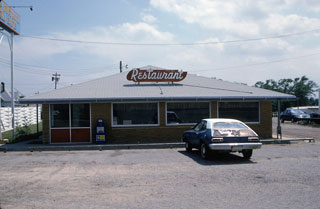
Pie-appreciation center (a.k.a. a Kansas diner)
Photo: Allen Bush
By Allen Bush
A car trip across Kansas, forty years ago, was an unending landscape of wheat stubble and Stuckey’s Pecan Shoppes—unavoidable if you were on a beeline to Denver or San Francisco. “Linger longer in Kansas,” the worn-out state tourism slogan, didn’t apply.
When Georg Uebelhart, my friend and Jelitto Perennial Seed colleague, came over from Germany for a visit in late May 1997, we did linger. Slivers of prairie remnants in Kansas and Nebraska had a peculiar appeal—more interesting, now, than the bright lights of the big western cities. Between us, we’ve traveled the Alps to the Altai and Andes poking around for plants. (Uebelhart, a native of Switzerland, has a sharp eye and an encyclopedic knowledge of plants – essential gifts for the best plant hunters.) It would be a stretch to call this work, but rarely does botanic obsession take on Indiana Jones-style intrigue, either. Occasional landslides and truck drivers, passing on blind curves, with perilous drop-offs and raging rivers hundreds of feet below have scared the wits out of us in a few far-flung places, but these aren’t worries in Kansas or Nebraska (though you should be careful for a speeding plantsman around Clarkson, Nebraska). The back roads in these parts are so desolate that an occasional passing car is more curious than death- threatening.
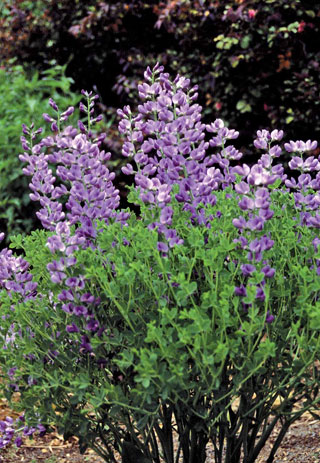 Baptisia australis var. minor, a pleasure of the Great Plains
Baptisia australis var. minor, a pleasure of the Great Plains
Photo: Courtesy of Jelitto Perennial Seed
We like to mosey (I was meant to linger). Anywhere we botanize, the routine is the same: periodic stops for fifteen minutes to an hour or more, to observe, photograph, and – where permissible—collect seeds or plants. But this overlooked corner of the world came as a surprise. Besides its magnificent flora, there are handsome, rugged parts that could pass for portions of Patagonia in Argentina (yes, the Plains states are that beautiful—even without the Andes for a backdrop). Kansas and Nebraska have water towers you can see for miles. Follow one of these and chances are you’ll find a small town diner. And, if you have a sweet tooth, you’ll discover why they call this the fruited plain.
Our first stop was the lovely Dyck Arboretum in Hesston, Kansas, about forty-five minutes north of Wichita. Larry Vickerman, then Dyck Director and now Director of the Denver Botanic Gardens at Chatfield, dared us to come-out for a prairie tour. He promised us we wouldn’t be disappointed with the plants or the arboretum (we weren’t!), but made no assurances about the weather. In a manner that suggested there was still time to back-out, he mentioned the possibility of tornadoes that could blow us to Kingdom Come, days that could turn on a dime from near freezing to blistering hot, and gumbo roads so mud-choked when it rained, we might never get unstuck.
We never saw a funnel cloud but we found pleasures you won’t find at Stuckey’s. Delphinium virescens grew happily in a ditch in the Flint Hills, near Cambridge. And a lovely, dwarf Tradescantia tharpii prospered with inhospitable dry soils in the Smoky Hill Region around Marquette. Throughout Kansas and Nebraska we saw blue spikes of the smaller False Blue Indigo, Baptisia australis var. minor. I told my nurseryman friend George Arnold, of LeRoy, Kansas, how breathtakingly beautiful I thought this species was. The former rancher, who needs few words to make a point, replied, “The cattle won’t eat it.” I felt vindicated a few years later when I spotted it growing luxuriantly in the gardens in front of Arnold’s Greenhouse. I still kid George about the littler Baptisia. (It’s still useless cattle feed, he reminds me.)
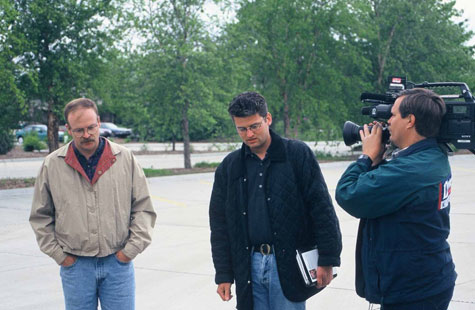
A Wichita TV cameraman followed plantsmen Larry Vickerman (left) and Georg
Uebelhart on a moseying botanical tour
Photo: Allen Bush
A Wichita television station got wind that a Swiss guy was wandering around looking at prairie plants. They sent a crew to tag along. Georg was asked —a half-dozen different ways—what was so wonderful about Kansas. “It’s beautiful!” he explained to a reporter who couldn’t quite understand why.
But plants were only half of it. Each day around noon, and later at dinnertime, we’d stop in a charming small town for nourishment. After the first lunch of cheeseburger, fries and a coke – one of many like this—the waitress, with hair up high, asked if we’d like a piece of pie. I politely refused. Vickerman took me aside as we left the restaurant and brought me to my senses. “You’re in pie country!” he told me straight-up. I had no idea a refusal of a fresh slice of pie was a breach of prairie protocol. When asked, next time, don’t hesitate, he said: “You ask, ‘What’s fresh?’”
For the next few days, in and around small Kansas towns like Lincoln or Matfield Green, we continued a ritual of plants and pies. Oenothera macrocarpa ssp. fremontii, Calyophus serrulatus and Penstemon grandiflorus were in season. So was strawberry-rhubarb pie. And selections of key lime, chocolate coconut, cherry, and apple were available in a pinch. You could overhear folks at nearby tables talking about the offerings and freshness of pie crusts. These were connoisseurs. Near mid-week, if further confirmation were needed, we witnessed an astounding rite of passage. We pulled into a country store, gassed-up and wandered in for some snacks (our craving for sugar by now addictive). A mother was ringing-up the cash register, as her ten year old boy came flying through, and she yelled-out, “Johnny, don’t run-off. Today you’re going to make your first pie crust!”
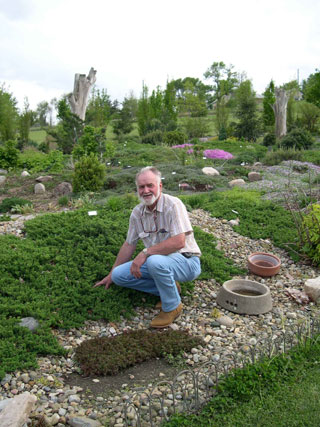 Harlan Hamernik, plantsman and rural driver extraordinaire, of Clarkson, Nebraska
Harlan Hamernik, plantsman and rural driver extraordinaire, of Clarkson, Nebraska
Photo: Allen Bush
Nobody loves plants of the Plains like Harlan Hamernik, founder of Bluebird Nursery in Clarkson, Nebraska; his wholesale company motto is: “If they’ll grow in Nebraska, they’ll grow anywhere!” Linger awhile with Harlan and your head will be spinning. His vast horticultural know-how is staggering, but as you head-off to a nearby prairie, his driving style makes Sichuan truck drivers look tame. I’ve never seen anyone barrel down a country road, scanning the uninterrupted horizon, barely looking at the road ahead, keeping-up his end of drive time banter, and still able to spot plants 150’ away, partially obscured by prairie grasses.
We pushed on to Ed Rasmussen’s Fragrant Path Nursery near Fort Calhoun, Nebraska. The weather had turned wet and cold, just as Vickerman had warned. Rasmussen mails-out a seed catalog each year that includes a fine list of rare heirloom flower, herb, grass, vine, tree and shrub seeds. Six days a week he oversees his commercial crops, packages seed orders, fusses over a substantial home vegetable garden and orchard, and tends his family’s private arboretum. On the seventh day, he bakes a pie. A man with a “love the one your with” outlook toward desserts, Ed said, “My favorite pie is generally the one I am eating at the moment.” His garden holds the key, but friends chip-in, too. In March he told me, “Yesterday we had a little lunch in the tool shed and Gretchen brought a rhubarb ginger custard (well, two) pie which was awfully good.” Ed confessed, “I generally don’t like it when people make pies as good or better than mine.” Then in a not so sheepish tone he added, “But by way of consolation, it doesn’t happen that often, and if I get to help destroy the evidence, that helps too.”
Linger over your own pie as long as needed. I’m certain all evidence will be eaten…
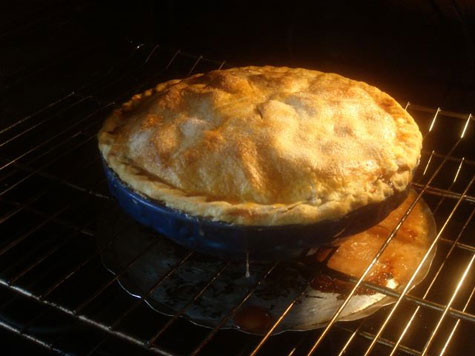
Precision baking: “420F for 10 minutes, then reduce the heat to 365F and bake an additional 45 minutes…”’
Photo: Ed Rasmussen
Here’s Ed Rasmussen’s recipe for peach-cherry pie:
“I prefer to use a 10 inch crockery pie dish as I like the way it bakes and it gives a good sized pie that can serve ten guests or eight very generously. If you do have some left over it’s always nice to have a piece of pie for breakfast. I don’t consider there to be any great secrets to my pie baking other than one must have a good, crisp, flaky crust and excellent, ripe, flavorful fruit that you have preferably picked yourself to insure it’s at the peak of ripeness. It’s impossible to make a perfect pie with imperfect fruit. It’s best to use fresh fruit in season but high quality frozen fruit will work especially if it is some you have put up yourself.
“We had peach-cherry pie this Sunday—nothing better. Our peaches didn’t set this spring so I went to the local orchard—theirs hadn’t set either but they had some very good ones from Alabama. Many orchards now have cooperative exchanges with orchards in other states where they buy or trade fruit that will be better than you can get at the grocery store as it needs less handling and can be picked riper. I supplied the cherries off our own trees.
“Use your favorite two crust recipe or if you don’t have one I recommend the following excellent and easy recipe for a 9 inch crust:
2 cup plus 4 tbsp unsifted all purpose flour
1/2 tsp salt
2/3 cup canola (or other oil)
4 tbsp water
“Blend the salt into the flour with a fork. Blend the oil into flour with the fork. Add the water and blend. Divide in half and press firmly into a ball. Flatten onto a sheet of waxed paper and cover with another sheet of waxed paper and roll into 12 inch circle.
“Remove the top layer of waxed paper and carefully invert over the pie dish. Remove the other waxed paper then fit the dough to the dish. To keep the crust from getting soggy after baking, whisk one egg with a tbsp water and brush the dough before adding the filling. Reserve this to brush the top crust before it goes into the oven.
“This recipe for pie dough was devised by the Mazola Corn Oil people years ago and it makes one of the easiest and best pie crusts. I have made crusts with lard or butter but most of my pie guests prefer the oil crust.
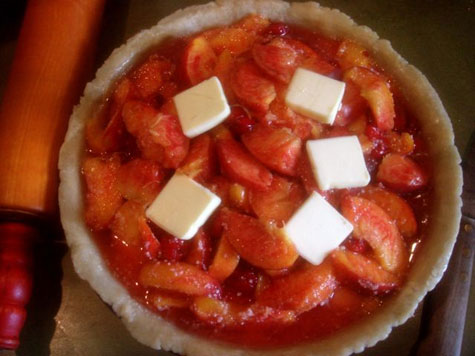
Never say no. Ask, ‘What’s fresh?’
Photo: Ed Rasmussen
Peach-cherry pie filling:
6 medium ripe peaches—well washed but not peeled—sliced and pitted
3 cups tart pie cherries, pitted
Juice of 1/2 lemon
3/4 cup granulated sugar—vary to taste, I like a tart pie
3 tbsp quick cooking tapioca or corn starch
4 pats butter
“Mix all ingredients except the butter in a bowl. Pour into the pastry lined dish, mounding in the center. Add the pats of butter. Cover with the top pastry and pinch around the edge. Brush with the egg glaze and sprinkle with a little granulated sugar. Make several slices in the center for vent holes. Set the pie in the lower third of a preheated oven (420F for 10 minutes) then reduce the heat to 365F and bake an additional 45 minutes or until the pastry is golden brown
and the fruit mixture begins to bubble and perhaps run over a bit.
“Aluminum foil or a pan made especially for the purpose of catching any filling that runs over is a good idea. If your peaches are not perfectly ripe (what a shame) or simply for complexity of flavor, you could add a little nutmeg, or a few drops of bitter almond, or a couple tbsp of port or sherry. Serve warm or cold….”
Comments
I never forget a good pie. Thanks, Georgia.


Oh my word that pie looks delicious.
Allen, do you keep a journal? Your recollection is amazingly detailed.